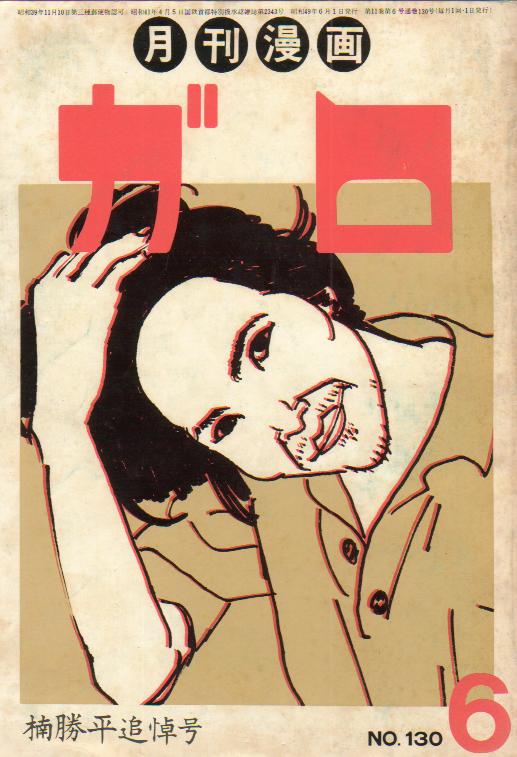- Garo (magazine)
Infobox Magazine
title = Garo

image_size = 200px
image_caption = June 1974 issue.
editor =
editor_title =
staff_writer =
frequency = Monthly
circulation =
category = undergroundavant-garde manga
company =
publisher =Katsuichi Nagai
firstdate = July 1964
finaldate = December 2002
finalnumber =
country =Japan
language = Japanese
website =
issn =nihongo|Garo|ガロ| was a monthly manga anthology magazine in
Japan , founded in 1964 byKatsuichi Nagai . It specialized in alternative andavant-garde manga .History
Katsuichi Nagai founded "Garo" in July 1964 with the help of
Sanpei Shirato , naming it after one of Shirato'sninja characters. The first series published in "Garo" was Shirato's ninja drama "Kamui", which with its themes ofclass struggle andanti-authoritarian ism was a hit with college students. Garo attracted several influential "gekiga " artists such asYoshihiro Tatsumi andYoshiharu Tsuge , and discovered and promoted many new artists."Garo"'s circulation at the peak of its popularity in 1971 was over eighty thousand. However, during the 1970s and 1980s its popularity declined—at some points in the 80s, by 150 copies per year. By the mid-80s its circulation was barely over five thousand, and its demise was rumored to be imminent. Nagai managed to keep it going independently until 1991, when it was bought out by a game software company. Although a new, young president was installed and advertisements for computer games (based on stories featured in "Garo") started to run in the magazine, Nagai was kept on board as chairman until his death in 1996.
After being bought out, there were allegations of the anthology taking a more commercial path. Eventually authors who were regular to "Garo" went their own ways and founded other anthologies like "Ax". "Garo" is no longer being published.
Styles and Influence
For much of its existence, "Garo" was the premiere showcase for "art" manga in Japan. It was popular enough during its heyday to inspire several imitators, including COM, founded by manga legend
Osamu Tezuka , andComic Baku .Over the years, "Garo" went through many artistic phases, including Shirato's leftist
samurai dramas,abstract art andsurrealism , erotic/grotesque, and punk. Unlike many of the popular anthology titles, the magazine never had a set theme to which the stories contained within it were required to conform; the only requirements were that they were interesting, and that their content was more important than their surface form.Although it was never considered a "major" magazine, "Garo"'s influence both within the manga business and in Japanese society as a whole has been considerable. Many
mangaka who got their start in "Garo" went on to do much higher-profile work elsewhere, and several films have been produced based on stories that originally ran in "Garo". Contemporarygraphic design in Japan owes much to "Garo" artists, particularlyKing Terry ,Seiichi Hayashi , and Shigeru Tamura. Retrospectives on the magazine have appeared in mainstream non-manga magazines, and in 1994 the Kawasaki city museum had a special exhibit of work by "Garo" alumni."Garo" in English
For the most part, most manga translation publishers have passed over the offbeat works showcased in "Garo" in favor of more mainstream, action/adventure and romance stories from the major publishers. Similarly,
scanlation translators have mostly overlooked experimental fare. However, some "Garo" comics are available in English.In the early 1990s, Viz Comics (now
VIZ Media ) published some of Sanpei Shirato's "Kamui" under the title "Legend of Kamui ". More recently,Blast Books has published books of avant-garde manga, including many pieces from the pages of "Garo". Even more recentlyThe Comics Journal published Yoshiharu Tsuge's work "Screw Style " in issue #250.In 2008 Drawn & Quarterly published "Good-Bye", the third volume of their ongoing edition of the work of
Yoshihiro Tatsumi . Some of the comics collected in "Good-Bye" originally appeared in "Garo".Mangaka associated with "Garo"
*
Masumura Hiroshi
*Carol Shimoda
*Hinako Sugiura
*Muddy Wehara
*Sanpei Shirato
*Shoichi Sakurai
*Tadao Tsuge
*Suehiro Maruo
*Kiriko Nananan
*Suzy Amekane
*Shungicu Uchida
*Seiichi Hayashi
* Shigeru Tamura
*King Terry
*Yoshiharu Tsuge
*Yoshikazu Ebisu
*Yoshihiro Tatsumi
*Nekojiru
*Shinichi Abe References
*"Dreamland Japan: Writings on Modern Manga" by
Frederik L. Schodt (ISBN 1-880656-23-X)
*Introduction to "Comics Underground Japan", edited by Kevin Quigley (ISBN 0-922233-16-0)
Wikimedia Foundation. 2010.
